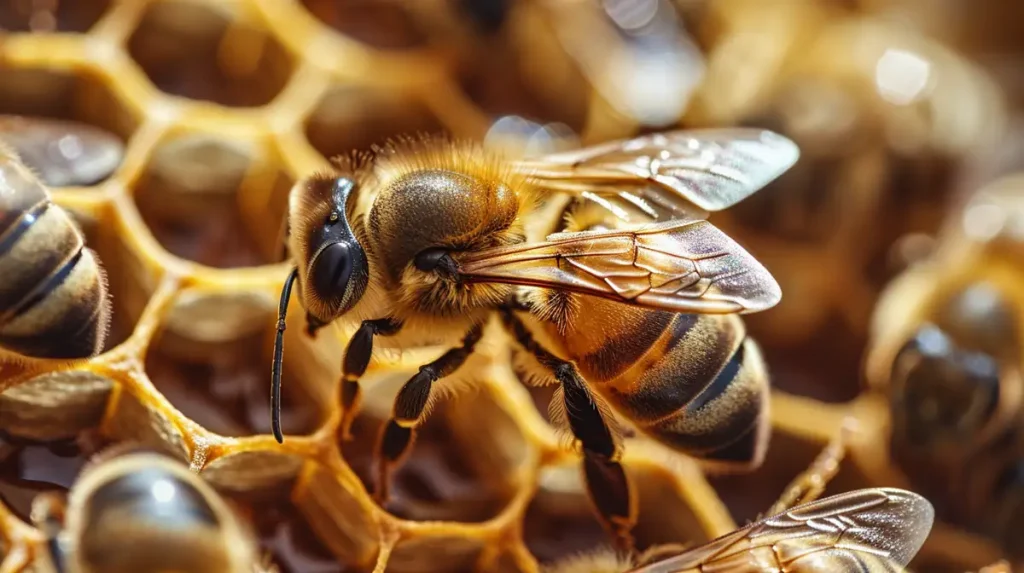Table of Contents
Yes, bees do sleep. Similar to many other creatures, bees have a rest period that can be likened to sleep. During this time, they exhibit reduced activity, slower metabolism, and increased thresholds to respond to external stimuli. Bees often sleep in the hive, with younger bees resting less than older foragers. Foragers are observed to have deeper and longer sleep periods, likely to recover from their exhausting work. Their sleeping posture includes relaxation of the antennae and often folding of their wings to cover their bodies. This rest is crucial for their health and efficiency in tasks like foraging and navigating.
In the below paragraphs, we will take a more detailed look at this topic.
During the warmer spring and summer seasons, bees are commonly observed hovering around flowers as they collect nectar. However, during the night or throughout the colder winter months their presence is noticeably absent. This raises several intriguing questions about the daily and seasonal activities of these vital pollinators. In this article, I am taking a deep dive into the sleeping patterns of bees as well as looking at some fascinating facts around this topic.
What Is The Role Of Sleep In A Bee’s Life Cycle?
The role of sleep in a bee’s life cycle is crucial for maintaining optimal health and productivity within the colony. As with humans, sleep allows bees to rest, rejuvenate, and process information, ensuring they are efficient in their daily activities.
Sleep Patterns in Bees
Bees, particularly honeybees, exhibit a sleep-like state known as quiescence. During this time, their body posture changes, with their antennae drooping and their legs collapsing beneath them. The duration and quality of sleep varies depending on the bee’s age and function within the colony. For instance, young bees typically sleep for short periods and wake up frequently while older foragers tend to sleep for longer stretches.
Impact on Learning and Memory
Sleep plays a significant role in a bee’s ability to learn and retain information. Researchers have discovered that well-rested bees are more adept at learning and remembering the locations of flowers and nectar sources. Furthermore, bees that sleep longer are better equipped to perform the famous waggle dance, a complex communication method used to inform other bees about the location of food sources.
Sleep and Colony Health
Adequate sleep is also essential for maintaining the overall health of a bee colony. Well-rested bees are more efficient in their tasks, such as foraging, nursing, and defending the hive. In contrast, sleep deprivation can lead to diminished performance and, ultimately, a weaker colony.
Do Bees Have A Specific Sleep Schedule?
Indeed, bees do have a unique sleep schedule that differs from many other creatures. These fascinating insects experience a sleep cycle that is influenced by various factors including age, tasks, and even the time of the year.
Worker bees, for example, exhibit a polyphasic sleep pattern, meaning they take multiple short naps throughout the day and night. As they progress through different roles in the colony, their sleep schedule adapts to their specific tasks. Younger worker bees that primarily tend to the brood inside the hive have more rest compared to older foragers, who are more active during the day. Foragers, however, still need to rest and typically take short naps on flowers or inside the hive.
Honeybees have an internal clock that helps them synchronize their activities with the day-night cycle. This circadian rhythm allows them to anticipate environmental changes and adjust their behavior accordingly. The presence of light, for instance, is a significant factor that influences their activity levels. Bees are predominantly diurnal, meaning they are active during daylight hours and rest during the night. However, their activity may vary with seasonal changes and they might exhibit slightly different patterns depending on the availability of resources such as nectar and pollen.
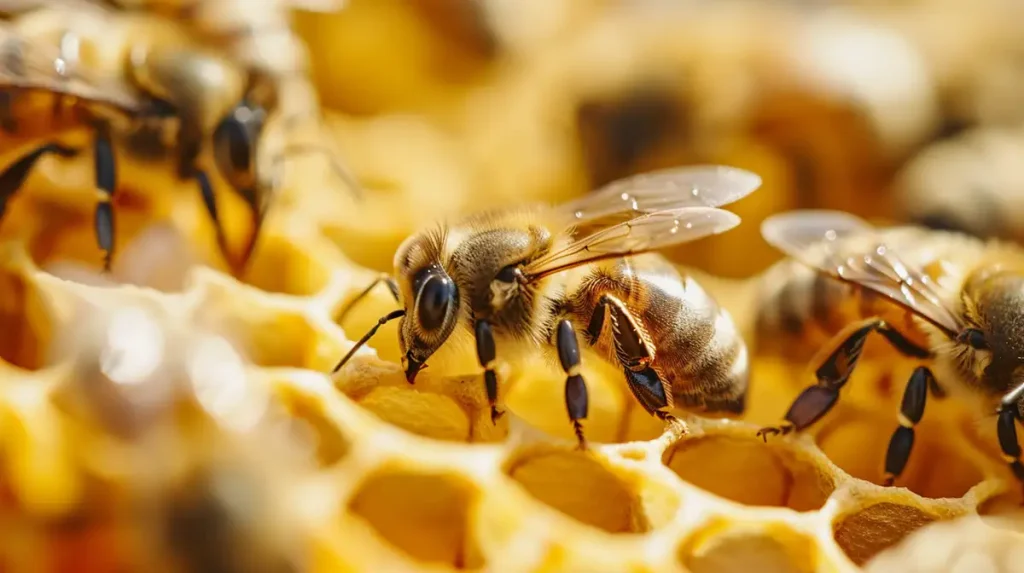
When Do Bees Sleep?
While forager bees tend to have a day/night schedule similar to humans, other bees within the hive have different sleeping patters. The forager bees are the older bees and they tend to be active from sunrise to sunset, heading out of the hive to collect nectar and pollen before returning and passing their goods to the waiting house bees. They will then head back out for another foraging trip and repeat this process throughout the day. By the time night falls, they are ready to sleep. Forager bees move through light, medium, and deep sleep and will then move from deep sleep to consciousness.
Younger bees in the hive also sleep very deeply but they tend to move between light, medium, and deep sleep before waking. They will also wake for a few hours and then fall back asleep again during the day and night.
- Carter, Anthony (Author)
- English (Publication Language)
- 194 Pages - 02/28/2024 (Publication Date) - Independently published (Publisher)
Factors Affecting Bee Sleep Duration
As discussed, the amount of sleep bees get is influenced by a variety of factors, such as their age, role within the colony, and environmental conditions. So a young worker bee often sleeps more than older ones as they require additional rest to support their rapid development. Similarly, forager bees might experience shorter sleep periods compared to those tending to the brood as their tasks demand more energy and longer hours. Additionally, external factors like temperature and food availability can also impact the sleep patterns of bees. In colder temperatures, they may sleep more to conserve energy while during times of abundant food supply they may sleep less to take advantage of the resources available.
Where Do Bees Sleep in a Beehive?
Within the beehive, bees exhibit unique resting behaviors and choose specific locations to sleep:
Forager Bees: Sleeping on the Job
Forager bees have a demanding job. After a long day of flying and gathering resources, these bees require sleep to recharge. They typically choose to sleep on the hive walls or towards the edges of the frames. This strategic positioning allows them to conserve energy and avoid interfering with the activities of other bees within the hive.
Younger Bees: Snoozing in the Honeycomb
Younger bees, also known as nurse bees or house bees, spend the majority of their time inside the hive tending to the queen, larvae, and other tasks. As they are not as exposed to external stressors, they can afford to rest closer to the center of the hive. These bees often sleep with their heads inside honeycomb cells, where they can remain protected and maintain their body temperature. Sometimes, they may even rest inside empty brood cells, which are the compartments where larvae develop.
Laying Low: Sleeping on the Hive Floor
In some cases, bees may choose to sleep on the floor of the hive, particularly when the colony is facing overcrowding or temperature fluctuations. This behavior can provide an additional layer of insulation for the hive, helping to maintain optimal temperature conditions. Additionally, sleeping on the floor may allow bees to rest undisturbed as they are not in the way of other bees moving about the hive.
Factors Influencing Bee Sleep Locations
Several factors can influence where bees choose to sleep within the hive. These include:
- Temperature: Bees are ectothermic, meaning their body temperature depends on the environment. Optimal temperature conditions are essential for bee survival, so they may select their sleeping location based on temperature regulation requirements.
- Colony size: As the population within the hive grows, space can become limited. Overcrowding may force bees to adjust their sleeping locations, finding any available space to rest.
- Age and role: As previously mentioned, a bee’s age and role within the hive play a significant role in determining their sleeping location. Younger bees remain closer to the center of the hive while forager bees rest near the periphery.
Understanding where bees sleep in a beehive provides valuable insight into the complex and fascinating world of these industrious insects. It is a testament to their impressive social structure and organization, allowing them to efficiently maintain their colony while still ensuring each bee gets the rest it needs.
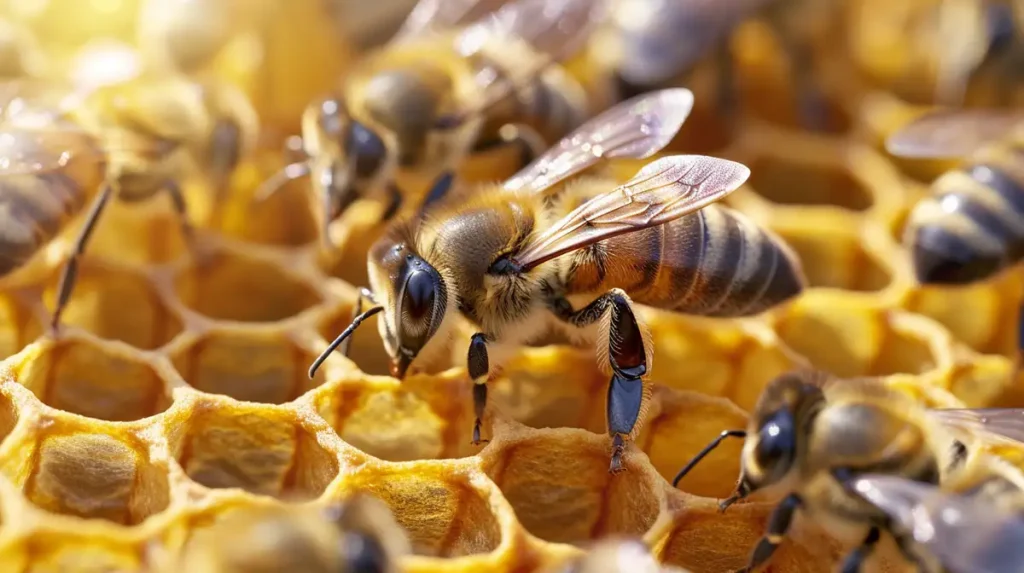
Do Bees Return to the Hive at Night?
As you know by now, forager honeybees leave the hive to gather pollen and nectar. They do this during the spring and summer months when the temperatures are warmer. How long they are out and about during the day really depends on how warm it is because once the temperature drops below 55F bees will start to go dormant.
In the mid-summer, you are likely to see bees out and about from early morning and they may still be flying about late into the evening. During the spring and fall though, they will leave the hive later in the day and will return to it earlier in the evening. Honeybees typically return to their hive at the end of the day about an hour before sunset. This is because once the light starts to dim they find it difficult to see very well.
How Can You Tell if a Bee is Sleeping?
Observing whether a bee is sleeping may not be as straightforward as it seems, but there are a few tell-tale signs to watch for. Typically, bees sleep at night, so you’re more likely to find resting bees during this time. Nevertheless, they can also take short naps during the day.
Body Position and Antennae Movement
One of the most noticeable indicators that a bee is sleeping is its body position. A resting bee will often cling to a plant or a surface with its legs, while its body hangs down, appearing more relaxed than when it is awake and active. Another sign to look for is the stillness of the antennae. When bees are awake, their antennae are constantly in motion, sensing their surroundings. In contrast, a sleeping bee’s antennae will be mostly motionless.
Reduced Responsiveness
A sleeping bee will also exhibit reduced responsiveness to external stimuli. While an awake bee will quickly react to disturbances, a resting bee may not respond immediately or may display a sluggish response. However, it’s important to note that bees can still be somewhat aware of their environment even while asleep, so approaching or touching a sleeping bee is not recommended.
Do Different Types Of Bees Have Different Sleep Patterns?
Indeed, sleep patterns in bees can vary depending on the type of bee and their specific role within the colony. There are over 20,000 known species of bees, but for the purpose of this discussion, I will focus on the European honeybee (Apis mellifera).
Worker Bees
Worker bees, which are all female, have different responsibilities based on their age. Younger worker bees, called “nurse bees,” tend to the needs of the brood by feeding and cleaning them. As worker bees age, they transition to foraging for nectar and pollen. Both nurse bees and foragers exhibit different sleep patterns.
Nurse bees tend to take numerous short naps throughout the day and night, amounting to about 8 hours of sleep in total. This fragmented sleep pattern is believed to help them remain responsive to the brood’s needs at all times. On the other hand, forager bees have a more consolidated sleep pattern, with most of their sleep occurring at night. Foragers require more rest than nurse bees, typically sleeping for 8-9 hours a night to recover from their demanding daily tasks.
Drones
Drones, or male bees, have one primary function: to mate with the queen. Interestingly, drones have a more relaxed sleep pattern compared to worker bees. They tend to sleep both inside and outside the hive, taking longer naps throughout the day and night. This more leisurely schedule is likely because drones do not have the same energy-consuming tasks as worker bees.
Queen Bee
The queen bee, responsible for laying eggs and ensuring the survival of the colony, has a unique sleep pattern. While it is difficult to quantify her exact sleep duration, it is believed that she sleeps more than the worker bees but her sleep is distributed across day and night to align with the needs of the colony.
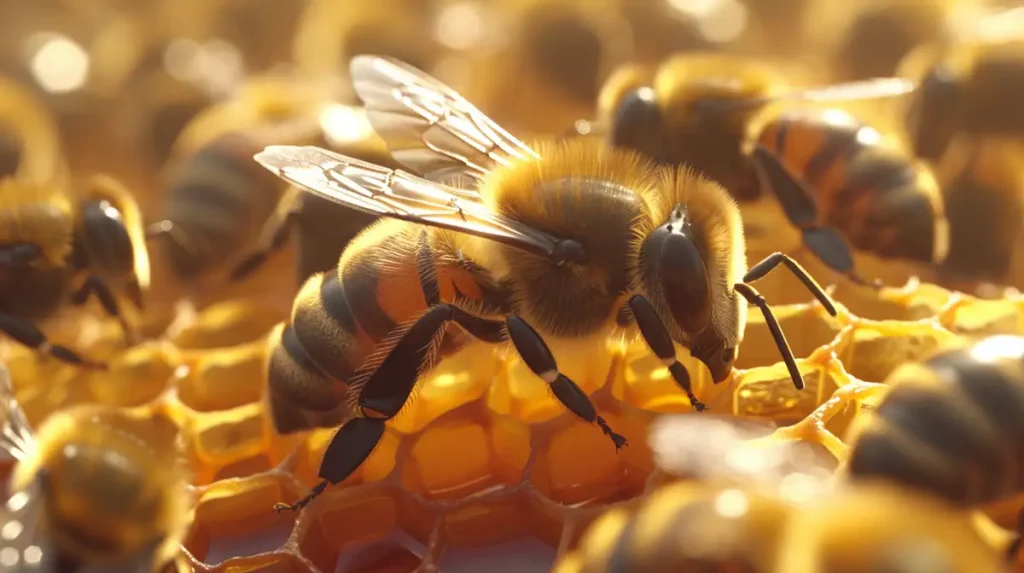
How Does Sleep Affect Bees’ Behavior And Productivity?
Sleep plays a crucial role in the lives of bees, much like it does in other animals. During rest, they undergo a number of physiological and cognitive processes that contribute to their overall well-being and productivity. In this section, I will explore how sleep impacts the behavior and productivity of bees.
Cognitive Function and Memory Consolidation
A bee’s cognitive function is closely linked to its sleep patterns. Sleep deprivation can lead to a decline in the ability to learn and memorize important information, such as the location of food sources or the distinctive characteristics of their surroundings. Adequate sleep allows bees to consolidate memories and learn more efficiently, ultimately enhancing their foraging skills and navigation abilities.
Social Communication and Coordination
The social dynamics within a hive depend on effective communication and coordination among its members. When bees experience a lack of sleep, their capacity to engage in these vital interactions diminishes. This can lead to a breakdown in the social structure, affecting the overall productivity and health of the colony.
Health and Immune System Function
Sleep is essential for maintaining a bee’s overall health and immune system function. A well-rested bee is more resistant to disease and parasites, which in turn helps ensure the colony’s survival. Conversely, sleep-deprived bees may be more susceptible to infections, which can spread throughout the hive and negatively impact productivity.
Can Bees Experience Sleep Deprivation?
Disrupting the natural sleep cycle of bees can have negative consequences on their health and overall colony function. Research has shown that sleep-deprived bees may experience reduced memory and learning abilities, which can negatively impact their ability to perform essential tasks such as foraging and navigation. Furthermore, sleep deprivation can lead to a decline in their communication skills, making it more difficult for bees to share information about food sources with other members of the colony. This could ultimately impact the overall productivity and survival of the hive.
What Happens When Bees Don’t Get Enough Sleep?
When bees don’t get enough sleep, their health, behavior, and overall performance can be negatively impacted.
Effects on Memory and Learning
Sleep plays a crucial role in memory consolidation and learning in bees. Inadequate sleep can lead to difficulty in retaining information about food sources and their surroundings. This can result in reduced foraging efficiency, as they struggle to remember the locations of flowers and other resources.
Impaired Communication
Bees rely heavily on their ability to communicate with their hive mates through the famous “waggle dance” to share information about food sources. A lack of sleep can cause a decrease in the accuracy of this dance, leading to misinformation being shared and inefficient foraging.
Reduced Colony Efficiency
A colony relies on its bees to work together efficiently to gather resources, tend to the brood, and maintain the hive. When bees are sleep-deprived, their ability to perform these tasks declines, which can lead to a weakened colony. A weak colony is more susceptible to diseases, pests, and other threats, potentially compromising its survival.
Increased Mortality
Finally, chronic sleep deprivation can have detrimental effects on a bee’s lifespan. Bees that do not get enough sleep may experience weakened immune systems and increased stress, making them more susceptible to diseases and other health issues. In turn, this can lead to a higher mortality rate among the sleep-deprived members of the colony.
How Do Bees Communicate While They Are Resting?
Bees utilize various methods to communicate with each other, even during their resting periods. One of the primary modes of communication while at rest is through vibrational signals. Bees can produce vibrations using their wings or body, which are then transmitted through the comb or the surfaces they are resting on. These vibrations can convey important information such as the status of the colony or the need for defense.
Another intriguing method of communication bees use during rest is through chemical signals, specifically through pheromones. Pheromones are chemical substances produced by bees that can affect the behavior or physiology of other bees within the colony. For example, the queen bee releases a pheromone known as the “queen mandibular pheromone” (QMP), which helps to maintain colony cohesion, suppress worker ovary development, and regulate foraging activities. Even when resting, bees are able to detect and respond to these pheromones, ensuring that the entire colony remains informed and harmonious.
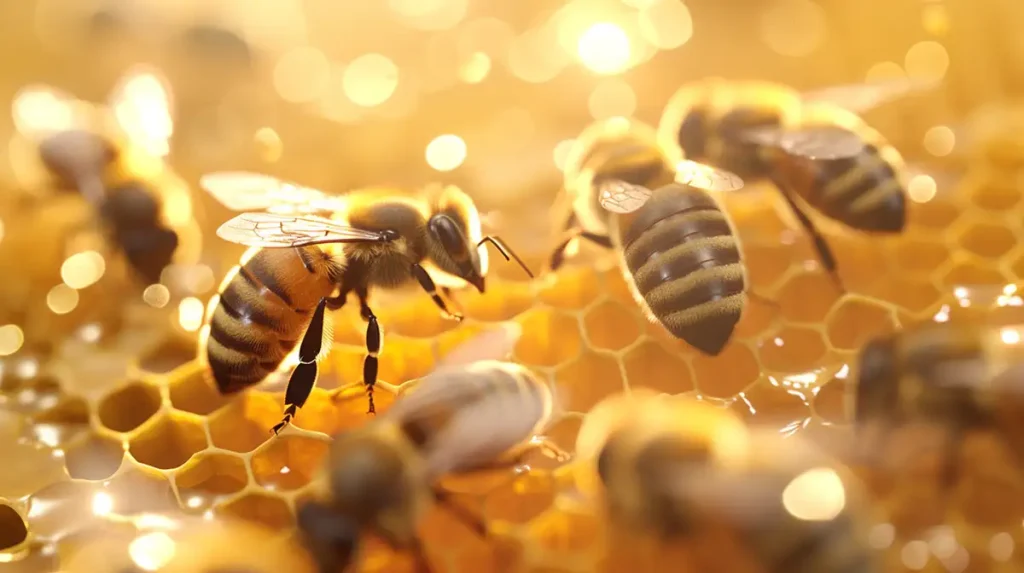
Are There Any Similarities Between Bee Sleep And Human Sleep?
Interestingly, there are some similarities between bee sleep and human sleep, even though they are vastly different species. One such similarity is the presence of distinct sleep phases in both species. While humans experience rapid eye movement (REM) and non-rapid eye movement (NREM) sleep stages, bees also go through different sleep stages characterized by specific physiological and behavioral changes.
Sleep Duration and Quality
Like humans, bees require adequate sleep for optimal functioning. Worker bees typically sleep for short periods, totaling around 30 minutes to an hour a day. However, during their sleep, they experience periods of deep rest, akin to the deep sleep stage in humans. This deep sleep is crucial for memory consolidation and overall cognitive functioning.
Circadian Rhythm
Another similarity between bees and humans is the presence of a circadian rhythm, an internal biological clock that regulates sleep-wake cycles. Bees have a strong circadian rhythm that influences their sleep patterns, foraging behavior, and navigation abilities. Similar to humans, bees’ circadian rhythms are influenced by environmental factors such as light and temperature.
Sleep Position
The sleep position of bees is also an interesting similarity. While humans typically lie down to sleep, bees sleep in a hanging position, with their heads down and antennae relaxed. However, the posture adopted by bees during sleep shares a common purpose with humans: to achieve a state of relaxation and reduce energy expenditure during rest.
Do Bees Sleep – Conclusion
Honeybees work awfully hard, whether they stay in the hive or leave it to forage for nectar, so they need to rest to get their strength back up. Like humans, bees go through various stages of sleep, from light to medium to deep.
Forager bees tend to work through the day and sleep at night while younger bees that stay in the hive will have cycles of sleeping and napping throughout a twenty-four-hour period.
FAQs
Q: Can bees sleep while flying? A: Bees do not sleep while flying. They need to be stationary and in a secure location to enter a sleep state.
Q: Do bees snore or make any noise while they sleep? A: Bees do not snore or make any noticeable noises while they sleep. They remain relatively quiet and still during their resting periods.
Q: Do all bee species sleep? A: While the sleep patterns and duration may vary, all known bee species require some form of rest or sleep to maintain their health and functionality.
Q: Do bees dream? A: While it is difficult to say for certain if bees dream, research suggests that they may have a form of dreaming during their sleep. Similar to humans, bees exhibit rapid antennae movement (RAM) while asleep, which could be comparable to rapid eye movement (REM) sleep in humans, when dreaming occurs.
Q: Do bees sleep more during winter? A: During winter, bees experience a change in their behavior, primarily due to lower temperatures and reduced food availability. While bees may not necessarily sleep more during this time, they tend to be less active and spend more time in the hive to conserve energy and maintain the colony’s temperature.
Q: Do baby bees (larvae) sleep? A: Bee larvae do not sleep in the same way that adult bees do. Instead, they go through periods of rest and activity as they grow and develop within the cells of the hive. This resting period allows them to conserve energy and allocate resources to growth and development.
Q: Can bees sleep during the day? A: Bees are primarily diurnal creatures, meaning they are most active during the day. However, if a bee is tired or needs to rest, it may sleep during the day, although this is less common. Some bee species, such as the night-foraging bees, have adapted to being active during the night and may sleep during the day.
Q: Can bees suffer from sleep disorders? A: There is currently limited research on sleep disorders in bees. However, like other animals, it is possible that bees could experience disruptions to their sleep due to factors such as environmental stress, disease, or other factors that could potentially lead to sleep-related issues.
Q: Do different bee species have different sleep patterns? A: Yes, different bee species can have varying sleep patterns. Factors such as their specific role within the colony, foraging habits, and environmental conditions can influence the sleep patterns of various bee species. Some species may be more active during the day, while others may be more active at night, leading to different sleep schedules.
Q: How do bees maintain their sleep schedule? A: Bees rely on environmental cues, such as light and temperature, to regulate their internal clocks and maintain a consistent sleep schedule. This circadian rhythm helps bees know when it is time to be active and when it is time to rest, ensuring they get adequate sleep for their overall health and functionality.
Q: How do bees signal that they need to sleep? A: Bees do not have an explicit way of signaling that they need to sleep. However, as their activity levels decrease and they become less responsive to stimuli, it may indicate that they are preparing to rest. Bees will then find a suitable location within the hive or near their nests to sleep.
Q: Do bees sleep more during bad weather? A: Bees may sleep more or be less active during bad weather, as unfavorable conditions can limit their ability to forage for food or perform other necessary tasks. In such situations, bees may choose to conserve energy and stay inside the hive until the weather improves.
Q: Can bees become nocturnal if needed? A: While most bees are diurnal, some species have adapted to being active at night and sleeping during the day. However, it is unlikely that a typically diurnal bee species would become nocturnal unless specific environmental factors or conditions required it to do so. The majority of bee species remain active during the day and sleep at night.
Last update on 2024-04-23 / Affiliate links / Images from Amazon Product Advertising API

